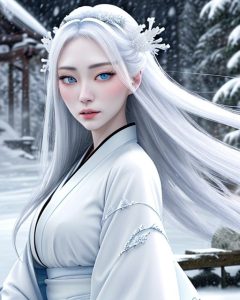Japan is renowned for its rich folklore, and among its captivating tales stands the haunting legend of the Yuki Onna, a story that has captivated the hearts and minds of many. Translated from Japanese to English, “Yuki Onna” simply means “snow woman.” This mystical figure is said to appear during intense snowstorms, bringing with her an ethereal presence that borders on enchanting.
According to ancient legends, the Yuki Onna takes the form of a breathtakingly beautiful woman, adorned with flowing lustrous hair, pale skin, and mesmerizing azure eyes. Draped in a white kimono that seamlessly blends with the snowy landscape, she truly embodies the essence of winter. However, one must not be deceived by her alluring beauty, for hidden within her is a chilling power – the ability to freeze unsuspecting souls with nothing more than a breath of icy cold air.
The Yuki Onna is particularly drawn to desolate, snow-covered landscapes such as mountains and forests, where she often preys upon hapless wanderers or stranded travelers. Gracefully gliding over the untouched snow, she leaves no trace of her presence, creating an otherworldly spectacle. With a touch as cold as death itself, she can drain the life force from her victims, rendering them powerless and depleted.
It is worth noting that despite her inherently chilling nature, Yuki Onna is not always portrayed as purely malevolent. Some versions of the folklore depict her as a sorrowful spirit, consumed by the grief of a lost love and forever searching for companionship. In these renditions, Yuki Onna reveals a flicker of compassion and mercy, sparing the life of a fortunate traveler on the condition that he promises never to speak of their encounter. These nuances in the legend add complexity to her character, blurring the line between good and evil.
The enduring legacy of the Yuki Onna folklore is a testament to its longevity and significance in Japanese culture. Passed down through generations, it continues to captivate the imaginations of those who hear it, serving as a cautionary tale against the dangers of venturing into treacherous snowy wilderness. Its enduring popularity is evident in its portrayal across various artistic mediums, including literature, art, and film, further exemplifying Japan’s profound fascination with the supernatural.

